In the Moment:
Michael Frye's Landscape Photography Blog
by Michael Frye | Feb 28, 2016 | Yosemite Photo Conditions
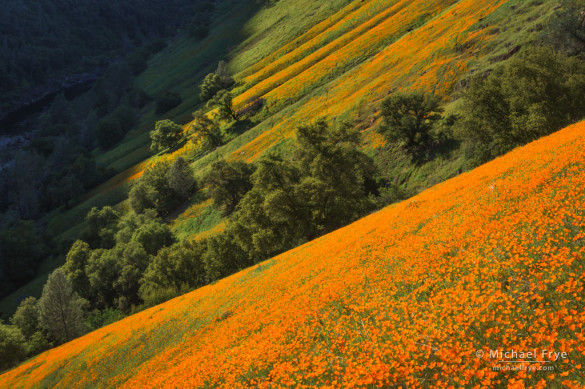
Poppies in the Merced River Canyon, April 2014
Spring has arrived early this year. It seems the poppies in the Merced River Canyon west of Yosemite liked the warm February weather we’ve been having, and they’ve been appearing in greater numbers over the last two weeks. On Friday, when Claudia and I drove up to Yosemite Valley for the Yosemite Renaissance opening reception, we saw some vibrant patches of poppies on the north side of the canyon (opposite Highway 140) a few miles easts of Briceberg. Other spots further east were just starting to show tinges of orange, but I expect those areas will become more colorful. It’s shaping up to be a good year for poppies in the canyon, but it’s just getting started, and the flowers are likely to last for several more weeks if the weather cooperates.
I’ve also seen photos of brilliant poppy displays in the southern Sierra foothills (east of Fresno and Bakersfield). And Death Valley is having a good bloom right now also. But southern California has received below-average rainfall so far this winter, so some of the best wildflower spots in the state like the Carrizo Plain and Antelope Valley probably won’t have great displays this year unless they get more rain soon.
(more…)
by Michael Frye | Feb 21, 2016 | Digital Darkroom, Vision and Creativity
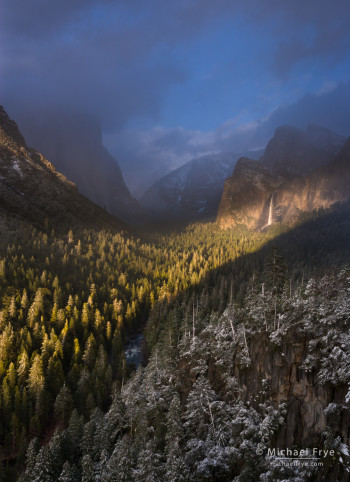
Beam of light striking Bridalveil Fall, Yosemite NP, CA, USA
“The term visualization refers to the entire emotional-mental process of creating a photograph, and as such, it is one of the most important concepts in photography.”
— Ansel Adams
I’ve become increasingly aware of the power of visualization over the years. Looking back through my own work, it’s clear that my best photographs were created when I had a strong response to a subject or scene, knew the feeling I wanted to convey, and was able to visualize in advance how I wanted the finished image to look.
But what does visualization mean, and how does it apply to digital photography today? Although Adams mostly talked about visualization in relation to technique, he also made it clear that visualization was part of the creative process. He wrote: “Visualization is a conscious process of projecting the final photographic image in the mind before taking the first steps in actually photographing the subject. Not only do we relate to the subject itself, but we become aware of the its potential as an expressive image.”
(more…)
by Michael Frye | Feb 19, 2016 | Light and Weather, Yosemite Photo Conditions
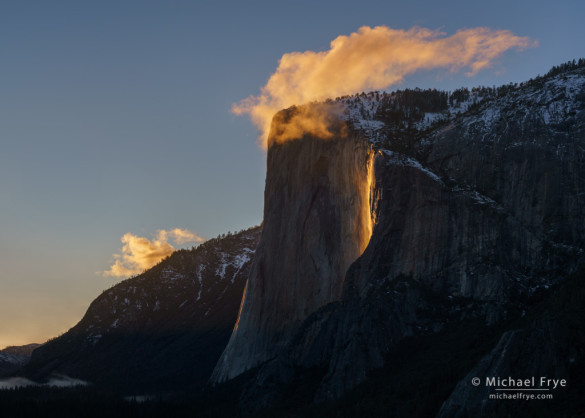
El Capitan and Horsetail Fall at sunset, Yosemite
I rose early yesterday morning to go up to Yosemite Valley, thinking the storm might clear just after sunrise. But showers persisted, and the sun didn’t break through until almost ten o’clock. By the time I finished photographing it was almost noon, so I decided to stay in the valley until sunset.
In the afternoon typical after-storm condensation clouds formed around the rim of the valley. Thinking those clouds might add something to a photograph of Horsetail Fall, and allow me to capture something a little different from my other images of this waterfall, I headed for a spot with a good overall view of El Cap and Horsetail.
(more…)
by Michael Frye | Feb 17, 2016 | Yosemite Photo Conditions
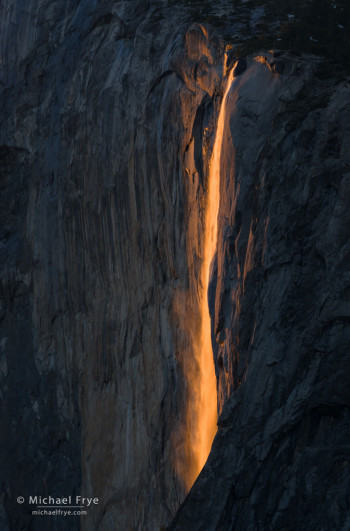
Horsetail Fall last night, 5:27 p.m.
February has been completely dry around here so far, with very warm temperatures. That warm weather has been melting the snow on top of El Capitan and creating a strong flow in Horsetail Fall – easily the most water in the fall since 2010. Yesterday was another clear, warm day (the high in Yosemite Valley was 67 degrees), with nearly ideal conditions for Horsetail. I wondered when I might see such conditions again, so I decided to head up to Yosemite Valley.
A first-hand look at Horsetail actually revealed less water than I expected. With the exceptionally warm weather we’ve been having I thought Horsetail would really be gushing, perhaps even approaching the high flow shown in this photograph from 1995. But nevertheless it was flowing well. I’d say the water level was a little above average for February (and, of course, way more than anything we’ve seen during the last four years of drought).
(more…)
by Michael Frye | Feb 14, 2016 | Composition, Vision and Creativity
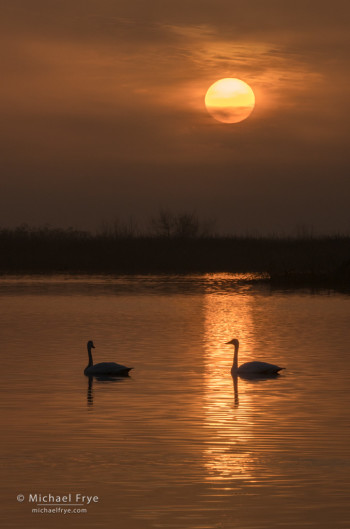
Tundra swans at sunrise in a San Joaquin Valley marsh
Happy Valentine’s Day!
This photograph of tundra swans seemed appropriate today. Swans mate for life, so you always see them in pairs, or in a small group when parents are joined by their young cygnets. The two subjects of this photograph were undoubtedly a mated pair.
One of the challenges of photographing these swans was that they kept their heads underwater for long periods of time while they were feeding. Periodically one of their heads would pop up briefly, but then plunge underwater again, and it was rare for both swans to have their necks raised at the same time. I expended many pixels trying to capture moments when both swans had their heads up. Even when I managed to catch both of them with their heads visible, often one of the swans would have its back to me, or be in some other awkward position.
But I stayed alert and patient, and eventually things came together. Both swans lifted their heads for maybe ten seconds – an eternity, it seemed – while I held down the shutter button. At one point the swan on the left even turned its head and looked back at the swan on the right. Perfect. That little gesture made a big difference in the photograph by creating a visual connection between the two swans.
(more…)













